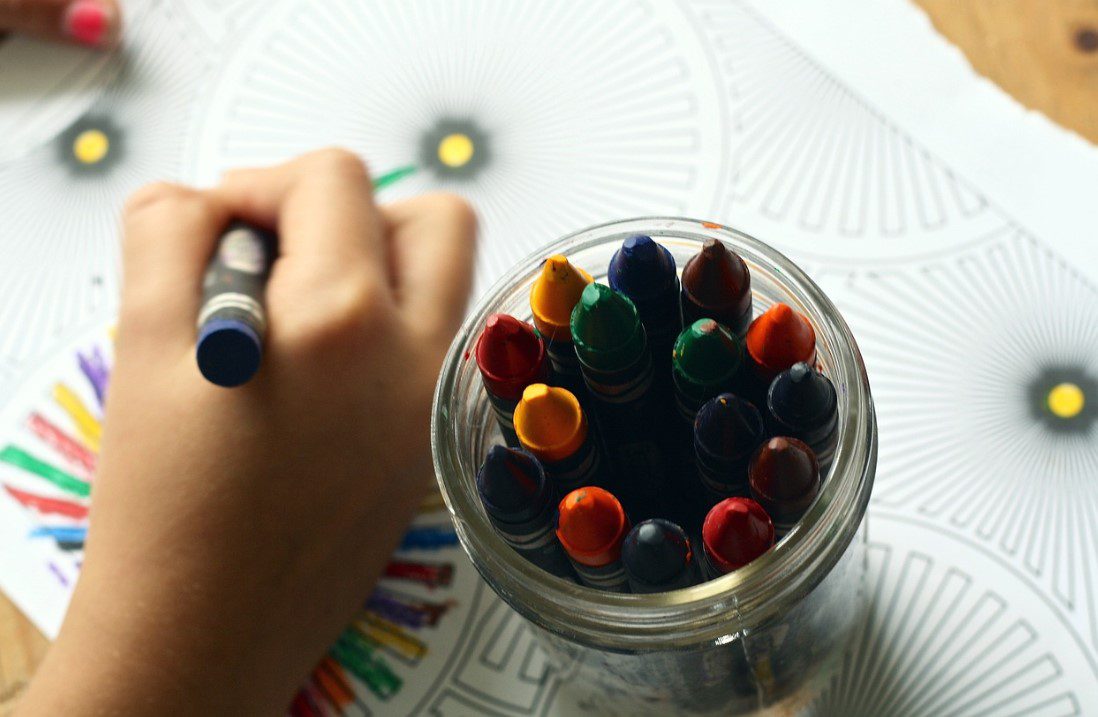In today’s dynamic and interconnected world, planting the seeds of creative thinking in children has taken on a renewed significance. Creative thinking is essential in helping them develop problem-solving skills, come up with innovative ideas, and have a deeper understanding of the world around them.
To do this correctly, they need to be given freedom and flexibility to explore, create, succeed, fail, try again, and everything in between.
Parents have to learn not to micromanage or dictate what children should create or not. Instead, children should be allowed to experiment and explore with different materials and ideas. This makes them develop their own unique style and approach to problem-solving.
In the following paragraphs, we explore some strategies that promote creative thinking and a lot more in children for their development.
1. Provide Creative Activities

There are many creative activities that can help children sharpen the mind and ultimately master the art of creative thinking. Here are a few examples:
Art: Art is a great way for children to express themselves and explore their creativity. The different types of art children can explore include painting, drawing, sculpting, and photography.
Music: Children can make music, play instruments, sing and dance.
Writing: They can also write stories, poems, essays, and even scripts.
Drama: They can act in plays, put on puppet shows, or even write their own scripts.
Dance: Children can learn different dances, create their own dances, or even choreograph dances.
Nature exploration: Nature exploration is a great way for children to be creative and to use their imaginations. They can explore the natural world and use their imaginations to create stories, poems, and other works of art.
Problem-solving activities: Problem-solving activities can help children think creatively and to find new and innovative solutions to problems. Some of these include puzzles, riddles, and games.
Additional creative activities for helping children develop creative thinking:
- Encourage them to be playful. Play is essential for creativity. When children play, they are free to explore their imaginations and to come up with new ideas.
- Provide them with a variety of materials and resources. Provide them with access to art supplies, books, music, and other materials that will spark their creativity.
2. Provide a Supportive Environment

Create a supportive environment where children feel safe to express their creativity and take risks without fear of failure.
Provide opportunities for creative expression: Offer a variety of materials and tools for children to explore and create with, such as paint, clay, paper, markers, and costumes. Encourage them to experiment with different techniques and approaches to art, music, dance, or other forms of creative expression.
Encourage open-ended play: Avoid directing children’s play or imposing specific goals or outcomes. Instead, provide opportunities for imaginative and unstructured play that allows them to explore and create in their own way.
Create a low-pressure environment: Avoid putting pressure on children to create “perfect” or impressive works of art or performances. Instead, focus on the process of creating and the joy of self-expression. Encourage them to create for enjoyment rather than for validation or praise.
3. Promote Playtime with Imagination

When children are allowed to play freely, they have the opportunity to explore their own ideas and interests. They also learn to think outside the box and come up with new and innovative solutions to problems.
Encourage them to engage in unstructured playtime outdoors, and avail materials that can be used in different ways. These may include arts and crafts materials, and dress-up costumes.
Playtime tips to promote creative thinking in children:
Encourage open-ended play. Open-ended play is play that does not have a specific goal or outcome. This type of play allows children to use their imagination and creativity to come up with their own ideas. Some examples of open-ended play include playing with blocks, dress-up clothes, or art supplies.
Provide plenty of materials. Children need a variety of materials to play with in order to be creative. This includes things like blocks, dress-up clothes, art supplies, and natural materials like leaves, sticks, and rocks.
You can also consider enrolling your child in extracurricular activities that align with their interests, such as music lessons or science camps.
4. Provide Opportunities for Expression

Providing children with opportunities for expression is crucial for their cognitive, emotional, and social development. Here are some ways to create such opportunities:
Encourage open communication: Encourage children to express themselves openly and honestly. Create a safe and supportive environment where they feel comfortable sharing their thoughts, feelings, and ideas.
Provide different mediums: Offer various creative mediums, such as art supplies, musical instruments, and writing tools, to encourage them to explore different ways of expressing themselves. Encourage them to express themselves through art, music, writing, or other creative pursuits.
Take them on outings that will spark their curiosity. This could include visiting a museum, going for a hike, or exploring a new neighborhood.
Provide them with opportunities to explore their interests. This could include art supplies, musical instruments, or building blocks.
Allow free play: Give children ample time for unstructured play, which allows them to use their imagination and creativity. They will come up with their own ideas and scenarios.
Listen to them actively: When children express themselves, listen attentively and respond with empathy and understanding. This helps them feel heard and validated.
Support social interactions: Encourage children to engage in social activities, such as team sports or group projects, where they can express themselves and learn to collaborate with others.
Model expression: Model positive expression by sharing your own thoughts, feelings, and ideas with children. This helps them learn to express themselves and communicate effectively.
When all goes well, encourage them to share their ideas with others, and provide feedback to help them improve. Display their creations and celebrate their achievements to boost their confidence. This will motivate them to continue exploring their creativity.
5. Promote Love for Reading

When children read wide, they are exposed to new ideas and ways of thinking. They also learn to use their imagination to create pictures in the mind. Reading helps them ask questions and explore the world around them.
Here are some tips for using reading and curiosity to foster creative thinking:
Read to your children every day. Make reading a part of your daily routine. Choose books that are interesting and age-appropriate.
Encourage children to read on their own. Once they are able to read on their own, make sure they have access to a variety of books. You can also encourage them to visit the library or bookstore.
Ask questions about the books they read. This will help them to think about the book and to make connections between the book and their own experiences.
Children who are curious and love to read are more likely to develop creative thinking skills.
Additionally,
Let them read books that involve problem-solving. Some examples include:
- The Giving Tree by Shel Silverstein
- Charlotte’s Web by E.B. White
- The Cat in the Hat by Dr. Seuss
6. Encourage Problem-Solving

Problem-solving is a skill that is essential for success in both school and life. It involves the ability to identify problems, generate potential solutions, and evaluate the pros and cons of each solution.
Children can learn problem-solving skills at a young age. Here are some tips for promoting problem-solving in children:
Encourage children to ask questions. When children ask questions, it shows that they are curious and that they are thinking about the world around them. Answer their questions in a way that encourages them to think critically and to come up with their own solutions.
Provide opportunities for them to solve problems. Offer them opportunities to solve problems in their everyday lives. For example, you could ask them to help you with chores, or you could give them puzzles or games to solve.
Help them to break down problems into smaller steps. When a problem seems too big or too difficult, it can be helpful to chunk it down into smaller steps. Chunking will make it seem less daunting and will make it easier to find a solution.
Teach them to brainstorm solutions. Brainstorming is a great way to generate a lot of ideas quickly. When children brainstorm, they should not be afraid to come up with silly or outlandish ideas. The more ideas they have, the better.
Help children evaluate solutions. Once they have generated a list of solutions, they need to evaluate each one. This means considering the pros and cons of each solution, and choosing the one that is most likely to be successful.
Additionally
- Play games that involve problem-solving. Some examples include:
- Puzzles
- Board games
- Video games
- Take children on outings that involve problem-solving. When children are exposed to new situations, they are forced to think critically and come up with solutions to problems. Some examples of outings that can promote problem-solving include:
- Hiking
- Camping
- Visiting a museum
Provide them with age-appropriate puzzles, games, brain teasers and challenges that require them to think creatively and outside of the box.
Ask them open-ended questions that encourage them to think critically and come up with their own solutions. Teach them to analyze problems, break them down into smaller parts, and explore different solutions.
7. Encourage Collaboration

Collaboration is the act of working together to achieve a common goal. It is a valuable skill that can help children learn to think creatively and solve problems.
Here are some ideas for how to use collaboration at home to promote creative thinking in children:
Encourage children to work together on projects. When children work together on projects, they are forced to communicate, compromise, and share ideas. This can help them to develop their creative thinking skills.
Set up a “makerspace” at home. A makerspace is a place where children can explore their creativity and make things. You can set up a makerspace at home by providing children with access to materials, such as art supplies, building blocks, and tools.
Encourage children to participate in extracurricular activities. Extracurricular activities, such as sports, clubs, and music lessons, can provide children with opportunities to collaborate with others and to develop their creative thinking skills.
Additional activities that promote collaboration and creative thinking in children:
- Play board games. There are many board games that are designed to promote creativity, such as Pictionary and Codenames.
- Do puzzles. hey can also help children develop their hand-eye coordination and fine motor skills.
- Build something. Building something, such as a birdhouse or a Lego, is great for creativity and collaboration. It can also help them develop problem-solving skills and understand engineering principles.
- Write a story. They can work with a partner or a group to brainstorm ideas, develop characters, and plot out the story.
- Make a movie. They can work with a partner or a group to write a script, shoot the movie, and edit it together.
Encourage children to work with others to develop their creative ideas. Provide them with opportunities to collaborate on projects and assignments. Teach them how to communicate effectively with others. Encourage them to share their ideas and listen to others’ perspectives. This promotes open-mindedness and creative problem-solving skills.
8. Use Screen Time to Promote Creative Thinking

Screen time is a ubiquitous aspect of modern childhood, and while it can have some negative effects, it can also be a tool for promoting creative thinking in children.
Here are some ideas for how to use screen time at home to promote creative thinking in children:
Use educational apps. There are many educational apps available that can help children learn about different subjects, such as math, science, and reading. These apps can also help children develop their creativity by encouraging them to solve problems, make choices, and explore new ideas.
Watch educational videos. There are many educational videos available on YouTube and other video streaming services. These videos can help children learn about different subjects, such as history, geography, and art. They can also help children develop their creativity by encouraging them to imagine different scenarios and create their own stories.
Play creative games. Some examples of creative games include Minecraft, Roblox, and Scratch. These games allow children to build their own worlds, create their own characters, and solve problems in new and innovative ways.
Use screen time to collaborate with others. Screen time can also be used to collaborate with others on creative projects. For example, children can use video conferencing to work on group projects, or they can use social media to share their work with others.
It is important to note that screen time should be limited, and that children should be encouraged to engage in other activities, such as reading, playing outside, and spending time with family and friends.
Additional tips for using screen time to promote creative thinking in children:
- Choose apps and videos that are age-appropriate and that encourage creativity.
- Set limits on screen time and make sure that children are taking breaks throughout the day.
- Talk to children about what they are learning and doing on their screens.
9. Emphasize the Process Over the Outcome

Encourage children to focus on the process of creating, rather than the outcome. This means emphasizing the importance of trying new things, making mistakes, and learning from them.
Avoid putting too much pressure on them to create a perfect end product, as this can stifle their creativity and make them less likely to take risks and explore new ideas.
Here are some tips on how to emphasize process over outcome for creative thinking in children:
Focus on the journey, not the destination. When children are working on a creative project, it is important to focus on the process of creating, rather than the final outcome. This will help them to be more open to new ideas and to take risks.
Encourage children to experiment. Experimentation is a key part of creative thinking. It allows children to explore different ideas and to find new and innovative solutions to problems.
Celebrate effort, not just achievement. It is important to celebrate children’s efforts, even if they do not succeed in achieving their goals. This will help them to stay motivated and to continue trying.
Provide a variety of materials and resources. Children need a variety of materials and resources in order to be creative. Provide them with access to art supplies, books, music, and other materials that will spark their creativity.
Create a positive and supportive environment. Children need to feel safe and supported in order to be creative. Create an environment where children feel comfortable taking risks and expressing themselves.
Additional activities that can help children emphasize process over outcome:
- Open-ended art projects. Open-ended art projects allow children to explore their creativity without any restrictions. Some examples of open-ended art projects include painting, drawing, and sculpting.
- Creative writing. Creative writing allows children to express their creativity through stories, poems, and other forms of writing.
- Problem-solving activities. Problem-solving activities allow children to use their creativity to find new and innovative solutions to problems. Some examples of problem-solving activities include puzzles, riddles, and games.
- Nature exploration. Nature exploration allows children to be creative and to use their imaginations. Some examples of nature exploration activities include hiking, camping, and playing in the backyard.
10. Model Creative Thinking

As a parent or caregiver, modeling creativity and innovation can also promote these skills in children. Engage in creative activities yourself, such as painting, writing, or playing music. Talk to your child about your own creative process, and encourage them to ask questions and share their own ideas.
Here are some ways parents can model creative thinking to promote the same in children:
Be a role model. Children learn by watching the adults in their lives. If you want your child to be creative, be sure to model creative behavior yourself. This means letting your imagination run wild and trying new things.
- Be playful. When parents are playful, they are free to explore their imaginations and to come up with new ideas. This can be done through activities such as playing games, telling stories, and making up songs.
- Be open-minded. Creativity requires a willingness to try new things and to be open to new ideas. Parents can model this by being willing to try new activities, such as cooking a new recipe or taking a dance class. They can also be open to their children’s ideas, even if they seem strange or unusual.
- Be supportive. Creativity can be risky. It often involves taking risks and making mistakes. Parents can help their children feel safe to take risks by being supportive and encouraging. This can be done by praising them for their efforts, even if they don’t succeed, and by helping them learn from their mistakes.
Additionally:
- When you’re cooking dinner, let your children help you come up with new recipes.
- When you’re driving, point out interesting things that you see and ask your children what they think they could do with those things.
- When you’re reading a story to your children, stop and ask them questions about what they think might happen next.
- When your children are playing, don’t be afraid to join in and be creative with them.
All in all …
Promoting creative thinking in children is essential for their personal and academic development.
While at it:
Be patient. Creativity takes time. Don’t expect children to be creative all the time. Just be patient and encourage them to keep exploring their creativity.
Praise their creativity. When your child does something creative, be sure to praise. This will help them to feel good about their creativity and encourage them to continue being creative.
Provide positive feedback. When children are being creative, it is important to provide them with positive feedback. This will help them to feel good about their efforts and to encourage them to continue being creative.
Avoid criticism. When children are being creative, it is important to avoid criticism. This will help them to feel safe to take risks and to be creative.
Celebrate your child’s creativity: Show interest and enthusiasm for your children’s creations, and display their artwork or performances in a prominent place in your home. Ask questions about their process and what inspired them to create a particular piece.





Leave a Reply